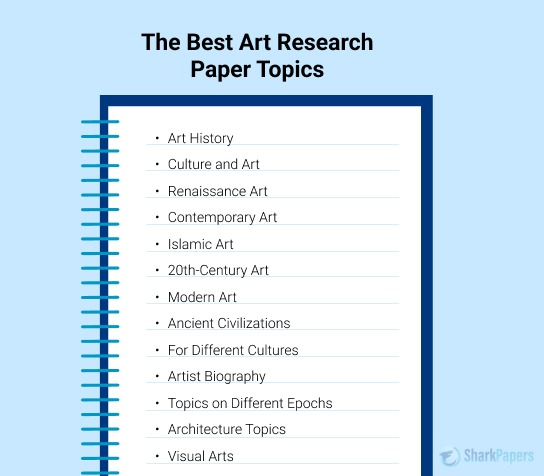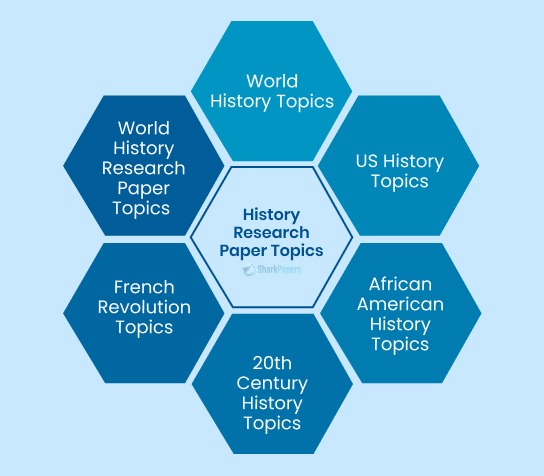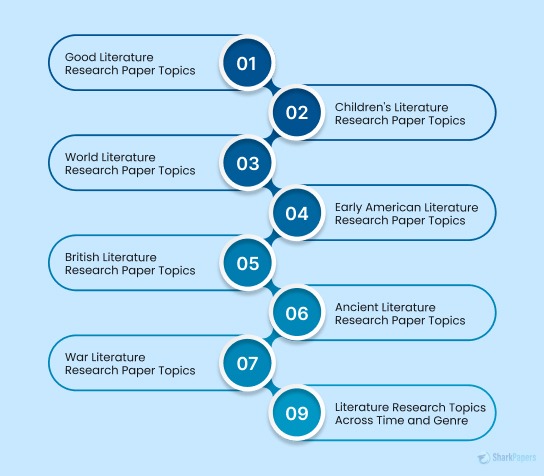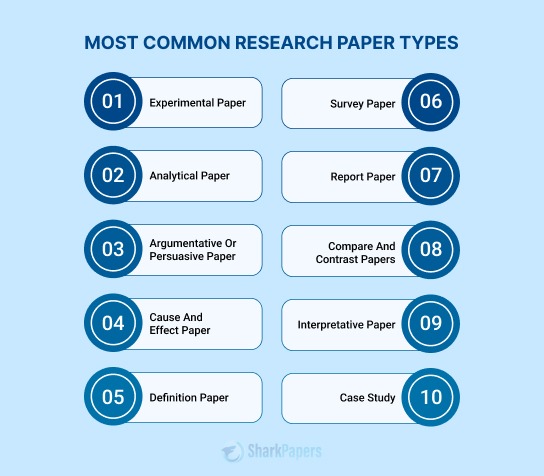Research Paper Writing Guides
Art Research Paper Examples
Last updated on: Dec 14, 2024

A Look at 10 Interesting Art Research Paper Examples
By: Sophia Lee
Reviewed By:
Published on: May 14, 2024

Many students struggle to write effective art research papers because they lack clarity on what makes for a well-crafted paper. They often find it challenging to organize their ideas and formulate a solid research paper .
Without clear guidance and examples to follow, you may struggle to compose top-notch art research papers. But our blog is here to help you!
By exploring examples of art research papers and implementing the tips and insights provided in this blog, students can gain a better understanding of how to write successful papers.
At first, we’ll briefly address what is an art research paper, then move on to the examples!

On this Page
What is an Art Research Paper
An art research paper explores a particular aspect of art, such as an artist, a movement, a period, a technique, or a specific artwork.
These papers are typically written by students, or researchers in the field of art history, art criticism, or related disciplines. One aspect of these papers involves exploring various types of research papers to analyze methodologies and approaches used in artistic inquiry.
Let’s move our focus on to the primary focus of this blog, art research paper examples!
Art Papers Examples for Students
Let’s explore and take a deep dive into some PDF examples suitable for students who need help with their art paper needs.
Art Research Paper Example PDF
Formal Analysis Essay Example
Art Analysis Essay Example
Art Research Paper Examples on Diverse Subjects
In this section, we’ll look at some more examples of research papers covering topics such as art history, art analysis, visual arts, and more. Take your time, and read them thoroughly for valuable insights and inspiration for your art research.
- Art History Research Paper Example : The Feminist Critique of Art History by Thalia Gouma-Peterson and Patricia Mathews
- Art Analysis Research Paper Example : Comparative study of mobile Raman instrumentation for art analysis by P. Vandenabeele, K. Castro, and H.G.M. Edwards
- Visual Arts Research Paper Example : Visual art in hospitals: case studies and review of the evidence by Louise Lankston, Pearce Cusack, and Chris Isles
- Theatre Arts Research Paper Sample : Theatre Arts for Improving Cognitive and Affective Health by Tony Noice, Helga Noice and Arthur F. Kramer
- State Of The Art Research Paper : The State of Art History: Contemporary Art by Terry Smith, University of Pittsburgh
- Artist Research Paper Example : How to identify artists? Defining the population for ‘status-of-the-artist’ studies by Sari Karttunen
- Art History Formal Analysis Example : A new canvas of learning: Enhancing formal analysis skills in AP art history through AI-generated Islamic art by Krista Carpino and James Hutson
Tips for Writing Effective Art Research Papers
When writing your art research paper, consider these straightforward yet invaluable tips to enhance your writing and analysis.
- Begin by choosing a captivating art research paper topic that interests you.
- Conduct thorough research using credible sources such as academic journals and books.
- Develop a clear thesis statement that outlines the main argument of your paper.
- Organize your ideas logically, with an introduction, body paragraphs, and a conclusion.
- Use descriptive language to analyze artworks, describing elements such as color, composition, and technique.
- Provide evidence to support your arguments, citing sources appropriately.
- Avoid generalizations and be specific in your analysis.
- Engage with different perspectives and interpretations to deepen your understanding.
- Revise and edit the research paper for accuracy, coherence, and grammatical correctness.
- Seek feedback from peers or instructors to improve the quality of your writing.
In conclusion, exploring examples of art research papers is a highly beneficial way to understand the qualities of a well-crafted, high-quality paper. Remember the insights and tips shared here, and continue to use art research paper examples to refine your writing skills.
If you're still unsure where to begin, seeking professional assistance from SharkPapers.com can greatly benefit your academic journey. We have academic writing experts who can deliver you top-notch and well-researched art research papers.
When you buy research paper from our experts, you can transform basic topics into polished, standout art research papers.
Feel free to place your ' help me write my paper ' request with us for personalized support and to take your writing to the next level!

Humanities and Arts Specialization
Sophia specializes in humanities and arts, offering a creative touch to research papers. Known for her innovative approach and ability to blend analytical thinking with a touch of creativity, Sophia has earned praise for bringing a fresh perspective to academic writing.
Was This Blog Helpful?
Keep reading.
- Learn How to Write a Research Paper: Step-by-Step Guide

- Everything You Need To Know To Conduct Effective Qualitative Research

- Types of Qualitative Research Methods with Examples

- Best 300+ Ideas For Research Paper Topics in 2024

- How to Write a Proposal for a Research Paper: Steps & Examples

- A Beginner’s Guide on How to Write an Abstract

- 13 Best Tips to Start a Research Paper

- How To Write An Introduction For A Research Paper - A Complete Guide

- Learn How To Write An Abstract For A Research Paper with Examples and Tips

- How to Write a Literature Review for a Research Paper | A Complete Guide

- A Guide to Writing The Methods Section of A Research Paper

- How to Write a Research Paper Thesis: A Detailed Guide

- How to Write a Research Paper Title That Stands Out

- A Detailed Guide To Writing a Research Paper Conclusion

- How To Write The Results Section of A Research Paper | Steps & Tips

- How to Write a Problem Statement for a Research Paper: An Easy Guide

- How to Find Sources for a Research Paper | Books, Articles, Journals & more!

- A Detailed Guide: How to Write a Discussion for a Research Paper
)
- How To Write A Hypothesis In A Research Paper - A Guide with Examples

- Learn How To Cite A Research Paper in Basic Formats

- The Ultimate List of Ethical Research Paper Topics in 2024

- 150+ Controversial Research Paper Topics to Get You Started

- How to Edit Research Papers With Precision: A Detailed Guide

- A Comprehensive List of Argumentative Research Paper Topics

- A Detailed List of Amazing Art Research Paper Topics

- Diverse Biology Research Paper Topics for Students: A Comprehensive List

- 230 Interesting and Unique History Research Paper Topics

- 190 Best Business Research Paper Topics

- 200+ Engaging and Novel Literature Research Paper Topics

- A Guide on How to Write a Social Science Research Paper

- Sociology Research Papers: Format, Outline, and Topics

- Understanding the Basics of Biology Research Papers

- How to Write a Psychology Research Paper: Guide with Easy Steps

- Exploring the Different Types of Research Papers: A Guide

- Scientific Research Paper: Types, Formats, Structure & Writing Process

- Argumentative Research Paper | A Step-by-Step Guide

- Analytical Research Papers: A Detailed Walkthrough

- Experimental Research Paper Explained Comprehensively

- An In-Depth Look at Psychology Research Paper Examples

- 15+ Research Paper Examples for Different Types and Formats

- Free Argumentative Research Paper Examples

- Refine Your Literary Skills with Literature Research Paper Examples

- Get Inspired by 10+ Biology Research Paper Examples

- A Comprehensive Guide to History Research Paper Examples

- An Extensive List of Business Research Paper Examples

- 10+ Best APA Research Paper Examples for Effective Writing

- 10+ Expertly Crafted MLA Research Paper Examples

- Explore 8+ Chicago Research Paper Examples for Academic Excellence

- 15+ Examples of Abstracts for Research Papers

- Exploring IEEE Research Paper Examples: A Practical Guide

- Exploring Research Paper Thesis Examples: A Beginner's Guide

- 10 Free Research Paper Proposal Examples
-12114.jpg)
- Survey Research Papers: Types, Format, Writing & Examples

- A Closer Look Into Research Paper Format: APA, MLA, Chicago & IEEE

- APA Research Paper Format 7th Edition: Guide with Examples

- MLA Research Paper Format Made Easy: Step-by-Step Guide

- Formatting Research Paper Title Page in APA, MLA & Chicago

- Crafting the Perfect Research Paper Outline | Steps & Examples

- A Detailed Guide to Chicago Research Paper Format

- An Easy Guide to IEEE Research Paper Format

- 12+ Practical Research Paper Outline Examples for Structuring Your Thoughts

- Engaging Psychology Research Paper Topics for Your Next Project

Struggling With Your Paper?
Get a Custom Paper Written at
with a FREE Turnitin report, AI report, title page, unlimited revisions, and a lot more!
LIMITED TIME ONLY
People Also Read
OFFER EXPIRES SOON!
© 2024 - All rights reserved
Disclaimer: All client orders are fulfilled by our team of experienced, professional writers. The essays and papers we provide are intended to serve as educational tools and reference models only, and should not be submitted as original work.
LOGIN TO YOUR ACCOUNT
SIGN UP TO YOUR ACCOUNT
- Your phone no.
- Confirm Password
- I have read Privacy Policy and agree to the Terms and Conditions .
FORGOT PASSWORD
- SEND PASSWORD
Visual Arts Research Paper

View sample visual arts research paper. Browse research paper examples for more inspiration. If you need a thorough research paper written according to all the academic standards, you can always turn to our experienced writers for help. This is how your paper can get an A! Feel free to contact our writing service for professional assistance. We offer high-quality assignments for reasonable rates.
Art comes from the Latin word ars, meaning skill, thus the term visual arts describes those skills that are visible to the human eye, including drawing, painting, sculpture, architecture, graphic art, decoration, and later photography and film. The visual arts are the expression of human creativity, a visualization of the way we see life and the world around us. Standing midway between what is perceived and what is believed, they stem from a need to make sense of human existence and explain it, both internally and externally.
Academic Writing, Editing, Proofreading, And Problem Solving Services
Get 10% off with 24start discount code.
One of the earliest forms of communication, the visual arts form a language through which humans speak about the world. This language is tempered by the society from which it springs, conditioned by its beliefs, its rituals, and its social codes. Pablo Picasso’s painting Guernica (1937), for example, can be fully understood only when related to the environment of the Spanish civil war (1936—1939). Likewise, every work of art has to be rooted in its own context, which is what gives it shape, function, and relevance—only then is it truly alive. During World War II (1939-1945) a Nazi officer showed Picasso a reproduction and asked, “Is it you who did that?” Picasso is said to have replied, “No, it is you.”
It is believed that the history of the visual arts begins with sculpture, the creation of a three-dimensional form. One of the earliest examples was the Lion-Human of Hohlenstein-Stadel, Germany (c. 30,000 BCE), a fantastic form carved from mammoth ivory. Half human and half beast, it marks the meeting of external reality with internal reality, and it is at this juncture that visual art occurs.
The decorative arts have always served both an ornamental and a functional purpose. Originating with the daubing of the body, it was an impulse that led to the fashioning of jewelry, pottery, glassware, textiles, and furniture. By 7000 BCE ceramic ware was already in use, and as decoration became more skilled and sophisticated different types of materials were adopted to create all kinds of objects. One of the most skilled and intricate early pieces was the Great Lyre from Mesopotamia (c. 2550-2400 BCE), which was created in the form of a bull’s head. Combining gold, silver, lapis, shell, and wood, it was both functional and beautiful.
Some of the most important elements of the visual arts are drawing, the creation of an image, and painting, the application of color to a surface. At Chauvet, in southwestern France, there are caves full of early drawings and paintings of animals (dating from 25,000 to 17,000 BCE). A visual expression of the world in which early humans lived, these pictures depict the beasts that were hunted and worshipped, and whose bones provided tools and weapons. Located far away from the living area, in the darkest part of the caves, these paintings evidently had a ritual and symbolic purpose. It is clear that both images and pictures were once things of power and that art itself played an important role in the everyday struggle of living; only today has it been relegated to a purely aesthetic role.
Beginning with the cave, architecture—”the enclosure of spaces”—also dates back to prehistoric times. As skills developed and resources increased, architecture became a statement about religion, power, and spectacle. The giant pyramids of Giza (c. 2601-2515 BCE) were the forerunners of today’s skyscrapers. Soaring toward the heavens, they proclaimed the divine status of the pharaohs and glorified the wealth, prestige, and stability of Egypt’s rulers. At 792 feet high, the Woolworth Building in New York (1911-1913) is almost twice the height of the tallest pyramid, yet the message it sends out is much the same. Built not from brick, but from steel, glass, and concrete, like the pyramid, it dominates the skyline. Imposing a sense of order and control, it proclaimed the supremacy of the United States as the richest, most powerful, and most technologically advanced society on Earth.
Despite its importance, advanced or sophisticated technology was not an essential requirement for artistic achievement. Fewer resources did not mean lesser skill. Although they did not use iron or steel, the Moche people of ancient Peru (200 BCE-600 CE) were exceptional potters and metalworkers. The Moche potters were renowned for making vessels in the form of human heads. Many of these heads are strikingly true to nature, and they show a mastery of the human face.
This highlights the fact that the development of the visual arts is not primarily a story of technical progress but a story of changing ideas. Each culture had its own idea of the world. This was embodied in images and structures that were far more potent than words could ever be.
For a long time art reflected the domination of knowledge over vision. Based not on what artists could see at any given time, it was conditioned by what they knew was there. It was the Greeks who first began to use their eyes, as their sculptors, artists, and craftsmen began to rely more and more on what they could see, feeling free to represent nature and the human body the way they saw it. This transition from knowledge to the visual marked the beginning of innovation.
In Europe, it was during the Italian Renaissance (fourteenth through seventeenth centuries) that the visual arts really began to mirror a fragment of the real world. The adoption of scientific perspective, the knowledge of anatomy, and the rediscovery of the inheritance of Greece and Rome added to the armory of artists, helping them master the portrayal of nature and enabling them to represent the world around them. Led by Leonardo da Vinci (1452-1519), artists began to explore the visible world, experimenting and searching nature as a means of deepening their understanding.
In China principles of theory and aesthetics were formulated as early as 500 CE by the scholar Xie He (500-c. 536). The emperor himself practiced painting, and schools were developed where art was taught as a subject. The first academy was established at the Song court in the early thirteenth century. The visual arts were thus placed on the same footing as the literary arts, and painters finally achieved a status equal to that of court officials.
The idea of art for art’s sake was also well established in China, and a distinction was made between amateurs and professionals, between those who worked for money and those for whom personal expression mattered most. This philosophy was first articulated by Ni Zan (1301-1374), one of the most famous painters of the Yuan dynasty, who was the first to assert the independence of the artist: “What I call painting does not exceed the joy of careless sketching with a brush. I do not seek formal likeness but do it simply for my own amusement” (Bush and Shih 1985, p. 266).
Power, Patronage, and Propaganda
Artists had always worked for patrons and institutions who specified what they wanted and rewarded the artist accordingly. In eighteenth-century Europe the initiation of regular exhibitions where artists sold their work completely changed the traditional pattern. Instead of working for patrons, artists now relied on exhibitions to sell their work, appealing to critics, connoisseurs, and the general public. Artists could now go their own way and make their own choices.
In Mayan society (350 BCE-900 CE) artists had enjoyed high status because of their ability to record, and for most of its history the visual arts had played an essential role in supporting the status quo. Around 1840 the discovery of photography transformed the artist’s position. Photography, the process of making pictures through the action of light, liberated the arts from the propagandist role that they had to play. There was now no need for painting to perform a task that a mechanical device could do far more effectively, and the camera took over as the principle means of recording, leaving artists free to criticize, comment, and give voice to their conscience and their creativity.
As a rule patrons and patronage systems did not encourage criticism of the existing social order. In societies such as Soviet Russia (1917—1991), where the state was supreme, the arts were run by government organizations, and artistic freedom was curtailed in order to promote the new social order. Patronage and the status quo also played a critical role in freer, more democratic societies. In 1932 the Mexican artist Diego Rivera (1886-1957) was commissioned to paint a fresco for the Rockefeller Center in New York, one of the most ambitious urban designs of the century. Rivera, however, included a portrait of Vladimir Lenin, leading John D. Rockefeller (1839-1937) to cancel the commission and have the unfinished mural destroyed.
Materialism
The advent of the Industrial Revolution had a profound impact on the decorative arts. The workshop gave way to the factory, while craftspersons and their individual skills succumbed to the machine and mass production. During the twentieth century, movements such as the Bauhaus (1919-1933) in Germany did their best to combat the effects of this trend. Combining the schools of art and craft, Bauhaus revived the creation of unique handmade objects. In an age driven by technology, the effect of these developments has been to place a premium on cost and time. This has made the possession of a handmade object even more desirable and even more exclusive than ever before.
As the expression of a living society, the nature of art was very closely tied to its material context. Economics often defined what artists could do, what they aspired to do, and the way in which their work was received. Centralization, urbanization, political stability, and control of resources were all key factors in this equation.
In Japan the growth of peace and prosperity during the Edo period (1603-1867 CE) fostered a vibrant cultural atmosphere. Literacy was widespread and the demand for art was so extensive that it could no longer be confined to a single group of patrons. This demand found its outlet in the affordable new medium of woodblock prints, which become the most popular art form of the day. Known as ukiyo-e (pictures of the floating world), they were filled with everyday subjects, reflecting the lives of the people who bought them. The two most famous series, Utagawa Hiroshige’s Fifty-three stages of the Tokaido (1833) and Katsushika Hokusai’s Thirty-six Views of Mount Fuji (c. 1826-1833), became the most popular sets of graphic art ever printed.
A striking characteristic of the visual arts is the way it often accompanies momentous changes in politics, economics, and science. The upheaval of the twentieth century led to revolutionary developments in art and culture.
Photography had compelled artists to explore areas where the camera could not go, encouraging them to discard convention and experiment. Like the scientists who discovered penicillin and atomic power, and the inventors who created the telephone, the car, the airplane, and the computer, artists too committed themselves to a process of experimentation and discovery. As they did so, they questioned the nature of art itself.
Led by Paul Cezanne (1839-1906) and Vincent van Gogh (1853-1890), and then Picasso (1881-1973) and Georges Braque (1882-1963), artists deliberately abandoned the previous attitudes toward accurate representation. It was no longer important to represent what people see; humankind had gained such mastery over the appearance of reality that the only way forward lay in abstraction and nonrepresentation, the reality behind realism.
Visual art now aspired to create something more relevant, more meaningful, and more lasting than a copy of an object or a depiction of nature. In this cause new techniques and materials were adopted that resulted in the breakdown of the distinctions between art and everyday life. This search led to a new feeling for the arts of Africa, Australasia, and America, where art was charged with an almost magical power and had a living function in society.

“Folk” Practice and “High Culture”
In Nigeria, the Yoruba people still believe that a parent’s love can reach a dead child through the medium of art. Nigeria has one of the highest rates of twin births in the world; when a Yoruba twin dies, a wooden image, ere ibeji, is carved and kept in the house by the parents. A symbol of hope for the future, the image is bathed and fed in the hope that the dead twin will bring the parents good luck. Described as “folk” practice, many of these art forms were the product of a community with a shared view of the world and a shared way of life. Rooted in tradition and less open to change, this art did not question but merely reflected the values of its society.
“Folk” art or practice was distinct from what was called high culture, a term that implies a more rarified culture with a greater level of luxury and sophistication and perhaps a different kind of patronage. Fostered by the state and the ruling elite for its own enjoyment, it also served to display power and glory. Unlike folk culture, high culture was not static or tied to tradition. Based on knowledge, experience, and understanding, it was, like art during the Italian Renaissance, in a constant state of evolution. This capacity to grow made it capable of change, and it was able to explore new issues and to question and break barriers. As the product of a community, many forms of folk art did not have a single author. High culture in contrast was often the product of individual discovery and endeavor. However this apparent difference may have been more the result of poor records and historiographic bias. What we do know is that the “high art” of Renaissance Italy was the result of individual genius, the work of such men as Leonardo da Vinci, Michelangelo (1475-1564), and Raphael (1483-1520), and as such its many forms were different and distinctive. The ceilings of the Sistine Chapel (1508-1512) in Rome, for example, would not have been painted in the same fashion by any artist other than Michelangelo.
The social impact of the visual arts is best summed up through the metaphor of film, the art of the motion picture. The youngest of the arts, the motion picture represents the logical development of everything that has come before. It was produced by recording a series of images with cameras and then showing them in rapid succession, thus giving an illusion of motion. Since the first commercial motion picture was made in 1898, the addition of sound and then color have made film arguably the most potent and popular art form of all. More so than other visual arts, it has an almost universal power of communication, possessing an ability to entertain, educate, enlighten, and inspire across countries and cultures.
Through film, culture has become truly global. Today the Coca-Cola logo is recognizable the world over in numerous languages. The visual arts are no longer indigenous—the product of one particular culture or experience. A universal language has become or is in the process of becoming a universal experience.
Bibliography:
- Bush, Susan, and Hsio-yen Shih, eds. 1985. Early Chinese Texts on Painting. Cambridge, MA: Published for the Harvard-Yenching Institute by Harvard University Press.
- Gombrich, E. H. 1984. The Sense of Order: A Study in the Psychology of Decorative Art. Oxford: Phaidon Press.
- Gombrich, E. H. 1995. The Story of Art. 16th ed. London: Phaidon Press.
- Honour, Hugh, and John Fleming. 2006. The Visual Arts: A History. 7th ed. Upper Saddle River, NJ: Prentice Hall.
- Hughes, Robert. 1991. The Shock of the New: Art and the Century of Change. Rev. ed. London: Thames and Hudson.
- Stokstad, Marilyn. 2005. Art History. 2nd ed. Upper Saddle River, NJ: Pearson/Prentice Hall.
ORDER HIGH QUALITY CUSTOM PAPER

- Art Degrees
- Galleries & Exhibits
- Request More Info
Art History Resources
- Guidelines for Analysis of Art
Formal Analysis Paper Examples
- Guidelines for Writing Art History Research Papers
- Oral Report Guidelines
- Annual Arkansas College Art History Symposium
Formal Analysis Paper Example 1
Formal Analysis Paper Example 2
Formal Analysis Paper Example 3
VISIT OUR GALLERIES SEE UPCOMING EXHIBITS
- School of Art and Design
- Windgate Center of Art + Design, Room 202 2801 S University Avenue Little Rock , AR 72204
- Phone: 501-916-3182 Fax: 501-683-7022 (fax)
- More contact information
Connect With Us
UA Little Rock is an accredited member of the National Association of Schools of Art and Design.
We use cookies to give you the best experience possible. By continuing we’ll assume you’re on board with our cookie policy

- A Research Guide
- Research Paper Examples
Paper Samples on Art
Eighteenth century art.
Institution Neoclassicism is the movement in arts that tends to draw inspiration from classical culture and art of ancient Rome and Greece. With increased popularity of what was popularly known as the Grand Tour, it became stylish to collect different antiquities as part of souvenirs. This is what spread the Neoclassical style through America and Europe. This report aims to...
Words: 367 | Pages: 2
Art and Community
A community refers to a given group of people sharing a common interest or having common linguistic and cultural background. It can also be defined as the geography or location inhabited by human beings. On the hand, there is no particular definition art, as it can be defined as a description of something’s beauty or an outstanding skill which results...
Words: 1686 | Pages: 8
Leonardo’s Milanese pupils
Leonardo Da Vinci. A master’s vision on ideal beauty inside Codex Urbinas and his Milanese students Chapter 1: Introduction Chapter 2: Beautiful Women in Renaissance portraiture Poems of women’s beauty in Renaissance portraiture Chapter 3: Leonardo’s beauty in Codex Urbinas Chapter 4: Leonardo and his pupils in Milan 1483-1499 Giovanni Antonio Boltraffio: Portrait of a Lady in the Clothes of...
Words: 3712 | Pages: 16
Unicorn Tapestries
The Cloisters museum started the preparation of the room where the Unicorn Tapestries would be displayed in 1998 (Preston).The Unicorn Tapestries are currently permanently exhibited at the New York’s The Cloisters (Margaret 2). Just as the unicorn, the tapestries can be considered the world’s marvels. This is because there is no other artwork where the magical creature is presented in...
Words: 496 | Pages: 3
By clicking "Log In", you agree to our terms of service and privacy policy . We'll occasionally send you account related and promo emails.
Sign Up for your FREE account
Writing About Art
Appendix iv: the research paper .
Doing the research
- The First Draft
The Final Draft
1. The assignment:
Write a research paper of 8-10 pages about a single object on display in the Greek and Roman Galleries at the Metropolitan Museum of Art. You must use at least four authoritative sources. At least two of them must have appeared in print form first. Cite them properly in your paper, using the Humanities version of the Chicago Manual style.
2. Selecting a topic:
The student went to the galleries of Greek and Roman Art at the Metropolitan Museum of Art and selected three objects as possible topics for his paper. The first was a Greek cuirass, the second a Roman portrait head, and the third a marble sarcophagus. He looked at all three, taking notes and photographing the details that seemed significant. It quickly became clear that the sarcophagus had many more aspects to discuss than the other works - its form, use, and complicated carvings with lots of figures arranged into different scenes. He then went to the website of the museum (www.metmuseum.org), which is easy to use because it is free, it is authoritative, and it contains a great deal of information about all kinds of works of art. In the case of these three objects, searching with the museum numbers as well as the descriptive titles from the wall labels, the student found a lot of information about the sarcophagus, but almost nothing about the other two objects. As a result, he selected the sarcophagus. BE PRACTICAL IN YOUR CHOICE OF TOPIC!
- Introduction
- Formal Analysis
- Personal Style
- Period Style
- "Realistic"
- The Biography
- Iconographic Analysis
- Historical Analysis
- Bibliography
- Appendix I: Writing the Paper
- Appendix II: Citation Forms
- Visual Description
- Stylistic Analysis
- Doing the Research
- The Final Paper
- About the Author
- ISBN: 978-1441486240 Paperback $10 Kindle Edition $1.99
© Marjorie Munsterberg 2008-2009

IMAGES
COMMENTS
May 14, 2024 · Art Analysis Research Paper Example: Comparative study of mobile Raman instrumentation for art analysis by P. Vandenabeele, K. Castro, and H.G.M. Edwards; Visual Arts Research Paper Example: Visual art in hospitals: case studies and review of the evidence by Louise Lankston, Pearce Cusack, and Chris Isles
This sample art research paper features: 6600 words (approx. 22 pages) and a bibliography with 52 sources. Browse other research paper examples for more inspiration. If you need a thorough research paper written according to all the academic standards, you can always turn to our experienced writers for help. This is how your paper can get an A!
Guidelines for Writing an Art History Research Paper by Dr. Laura J. Crary, Art Department I. Organization The research paper takes one of two forms: analytical and narrative. The first sets up a problem or argument, then provides evidence to support whatever position you, the writer, have chosen.
Art History Research Paper Sample. Studying art history includes examining artworks, understanding their historical context, and learning about the artists. This helps analyze and interpret how art has evolved over various periods and regions. Check out this sample paper analyzing European art and impacts:
The art research paper examples feature analyses of artistic expressions across different cultures and historical periods. These papers cover a variety of topics, including art history, criticism, and theory, as well as the examination of specific artworks or movements.
View sample visual arts research paper. Browse research paper examples for more inspiration. If you need a thorough research paper written according to all the academic standards, you can always turn to our experienced writers for help. This is how your paper can get an A! Feel free to contact our writing service for professional assistance.
Formal Analysis Paper Example 1 Formal Analysis Paper Example 2 Formal Analysis Paper Example 3 VISIT OUR GALLERIES SEE UPCOMING EXHIBITS
Free research paper examples on Paper Samples on Art. Look through the list of samples written by academic experts and get an idea for your paper. We use cookies to give you the best experience possible.
In beginning to cursorily explore modern European Art, between the 15th century and the 19th century inclusive, and in order to stay within the scope of this research paper primer on the issue, it is useful to begin with a definition of what art is. As Gombrich (1984) notes: “There really is no such thing as Art. There are only artists” (p. 4).
APPENDIX IV: The Research Paper SECTIONS: Doing the research. The First Draft. The Final Draft . 1. The assignment: Write a research paper of 8-10 pages about a single object on display in the Greek and Roman Galleries at the Metropolitan Museum of Art. You must use at least four authoritative sources.